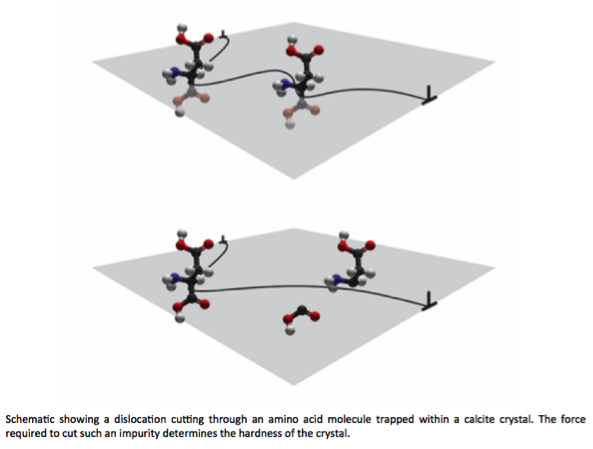
|
|
 |
 |
|
Home People Research Thin films Bio-inspired minerals Oxide glasses Nanostructured metals Nanostructured ceramics Group News Publications Facilities Available Positions Alumni | Bio-inspired minerals Nature makes excellent use of minerals in a variety of biogenic structures such as sea shells and bone. These materials are often structured at the nanoscale to give them very high toughness or strength compared with pure single crystalline forms. We wish to understand deformations and strengthening mechanisms in such materials at a fundamental level, with the ultimate goal of applying such knowledge towards the improvement of man-made structural materials. Effect of occlusions on mechanical properties of calcite Calcite (CaCO3) is a common mineral found in both geology (e.g., rocks like limestone and shale) and biology (e.g., the shells and teeth of marine organisms). Relatively pure and perfect “reference” crystals of calcite that can be found in geology are inherently soft and brittle—for example, such crystals can be pressed together to make the crumbly chalk used for writing on blackboards. However, biology somehow manages to use the same mineral ingredient to make protective structures that are much harder and tougher than reference calcite. We want to understand how this works.
References Kim, Y.Y.; Semsarilar, M.; Carloni, J.D.; Cho, K.R.; Kulak, A.N.; Polishchuck, I.; Hendley IV, C.T.; Smeets, P.J.M.; Fielding, L.A.; Pokroy, B.; Tang, C.C.; Estroff, L.A.; Baker, S.P.; Armes, S.P.; Meldrum, F.C. “Structure and Properties of Nanocomposites Formed by the Occlusion of Block Copolymer Worms and Vesicles Within Calcite Crystals.” Advanced Functional Materials, 2016. Accurately interpreting experimental factors that affect nanoindentation measurements In order to accurately calculate the hardness and elastic modulus of a sample by the standard nanoindentation analysis, the sample must be mechanically isotropic, relatively large and homogeneous, and rigidly supported. On the other hand, biogenic and bio-inspired synthetic minerals are often highly anisotropic, very small, and supported by heterogeneous material. Hence, measuring the mechanical properties of such crystals is not straightforward. To address the effect of anisotropy on nanoindentation measurements of the bio-relevant mineral calcite, we work with collaborators at Hysitron, Inc. to measure a pure reference calcite at a range of crystal orientations and connect the differences in measured hardness to fundamental deformation mechanisms in the crystal [1]. We have also used small synthetic calcite crystals as model system to develop a new and improved nanoindentation method that can account for and subtract the effect of heterogeneous material surrounding small particles of interest [2]. Together, these studies provide guidelines for accurately interpreting nanoindentation measurements on calcite crystals, and the lessons learned here are expected to be applicable to such measurements made on a variety of other anisotropic and/or small particle materials. References [2] Carloni, J.D.; Mason, J.L.; Jordan, T.E.; Estroff, L.A.; Baker, S.P. “Measuring the elastic modulus and hardness of particles within a dissimilar matrix using instrumented indentation.” In preparation Measuring the mechanical properties of mineral grains in sedimentary rocks The mechanical properties of sedimentary rocks (e.g., limestone and shale) are important for a variety of reasons, including resource-recovery by hydraulic fracture. Such rocks are a complex hierarchical composite consisting of sub-mm and sub-micron mineral and organic constituents as fundamental building blocks. The macroscopic fracture properties of these rocks must be related to the microscopic response of the constituents. In this work, we collaborate with researchers in other departments here at Cornell to use nanoindentation to measure the mechanical properties of the small mineral grains that make up various types of sedimentary rocks. We are able to separate the effect on the measurements of heterogeneous material surrounding the mineral grains by applying the lessons we learned from making similar measurements on small bio-inspired synthetic calcite crystals. Specific goals include making the connection between microscopic material properties and macroscopic mechanical behavior, and studying the effect of rock-forming processes on the mechanical properties of mineral fossils trapped inside these rocks.
References |
 |
|
 |
|
| Last Update: 2016/12/22 | JDC | <-- Click these initials to email the webmaster with comments / suggestions |

